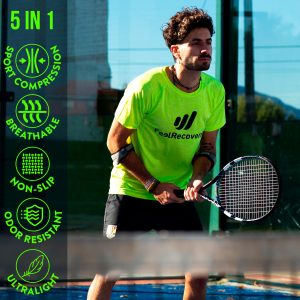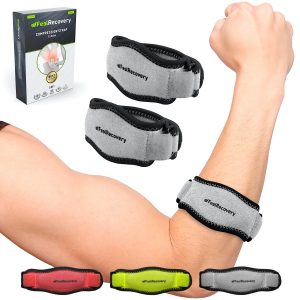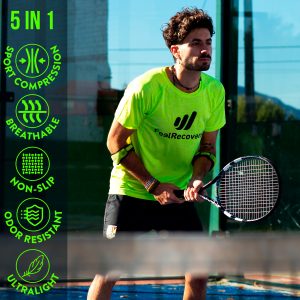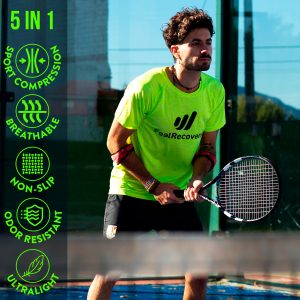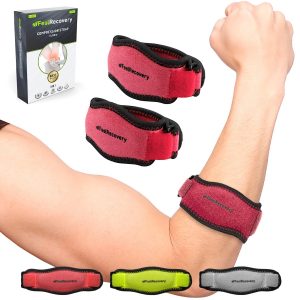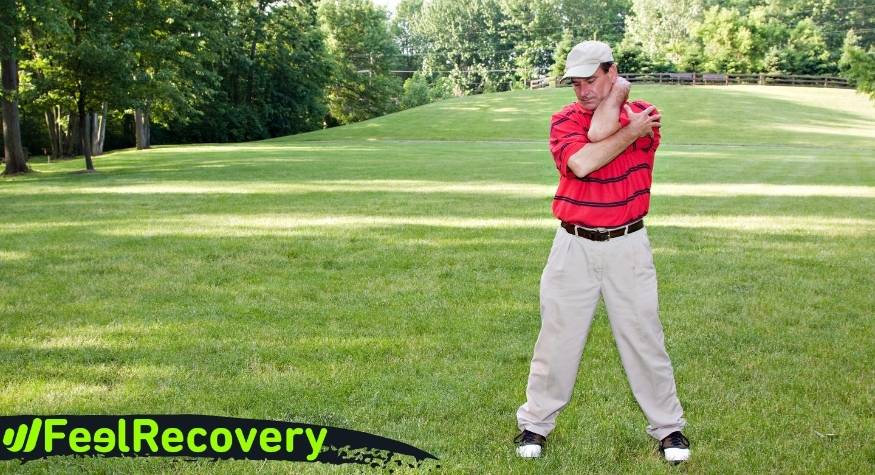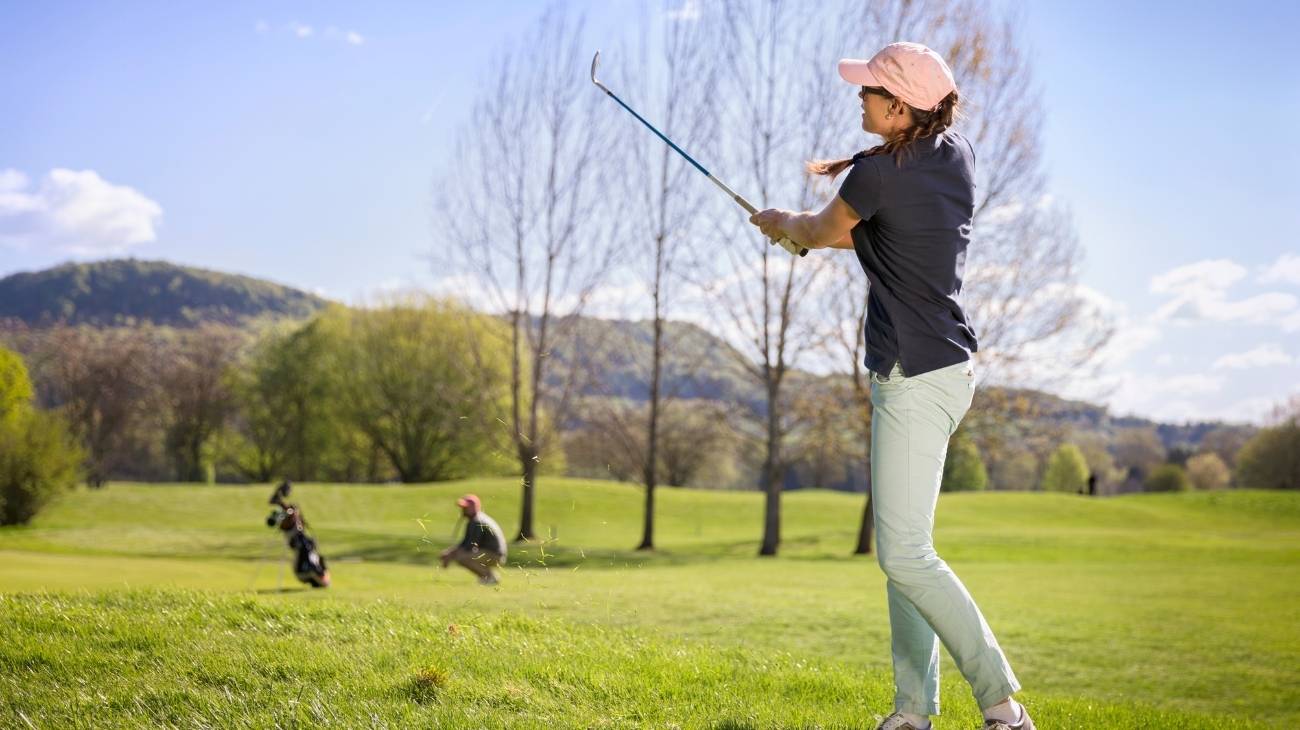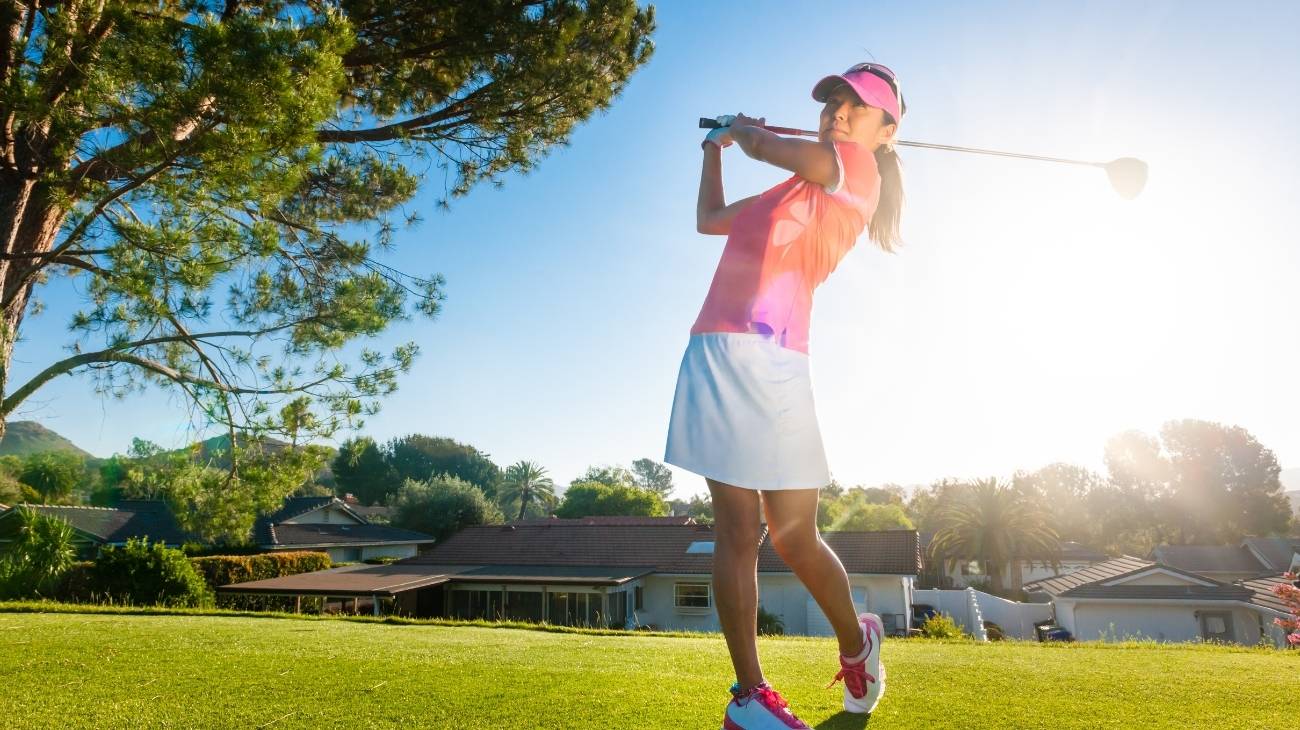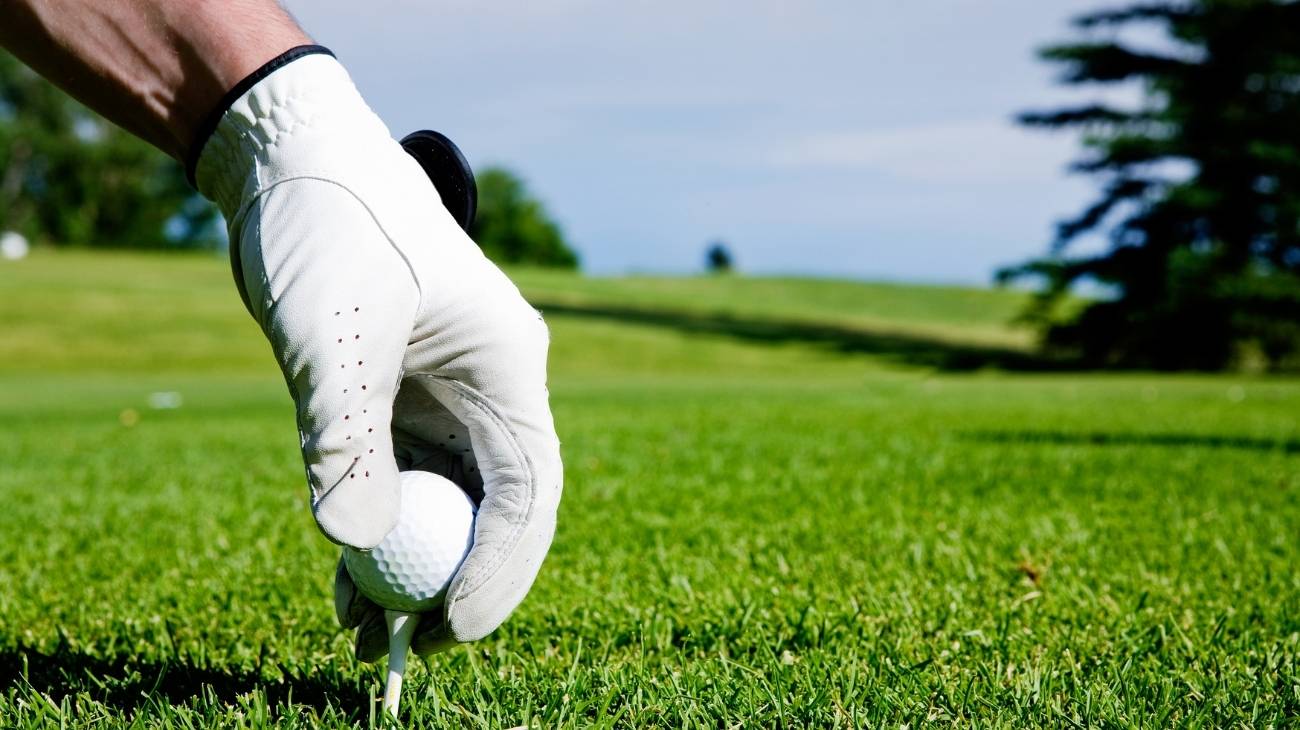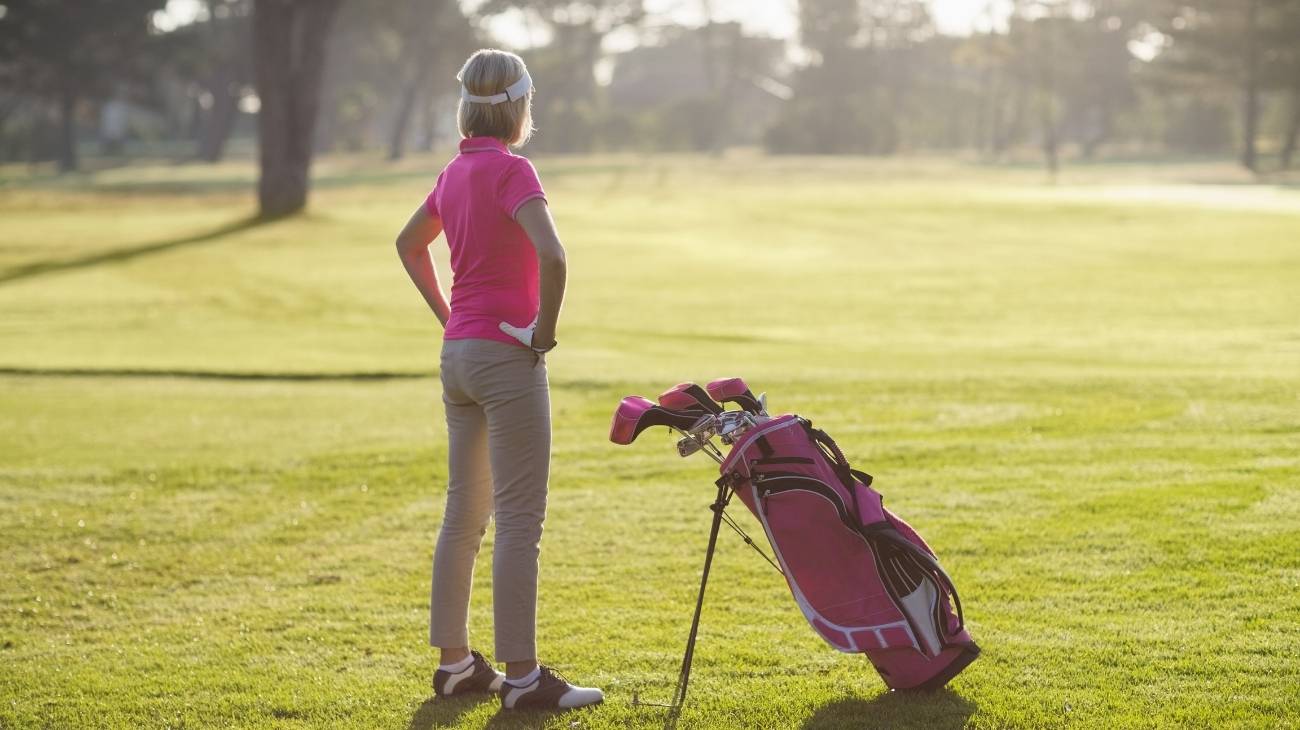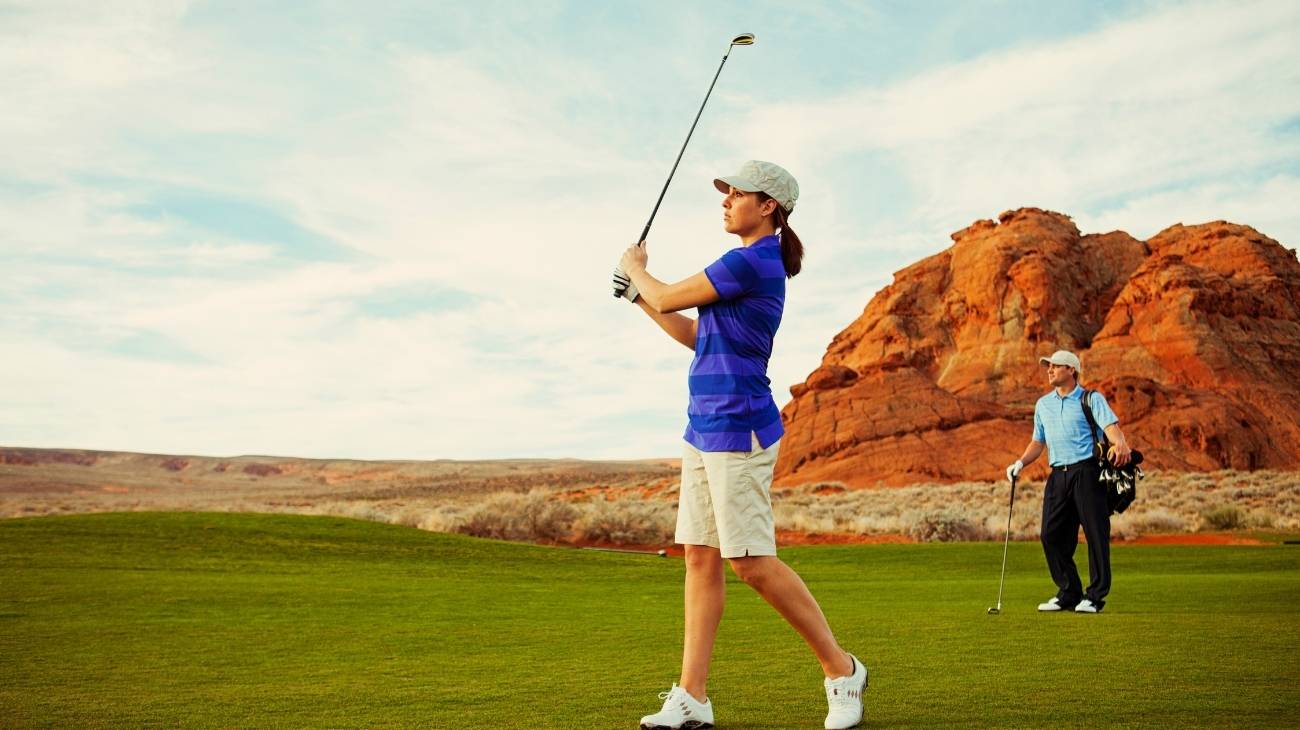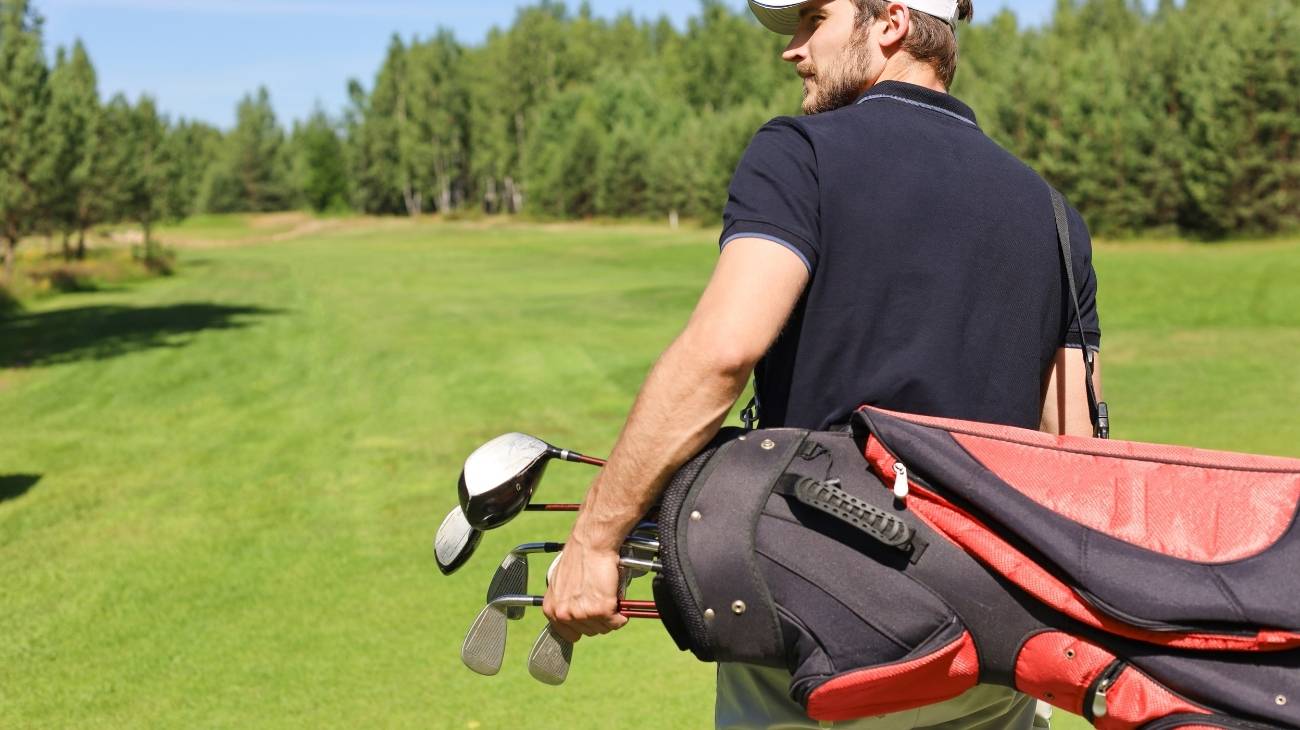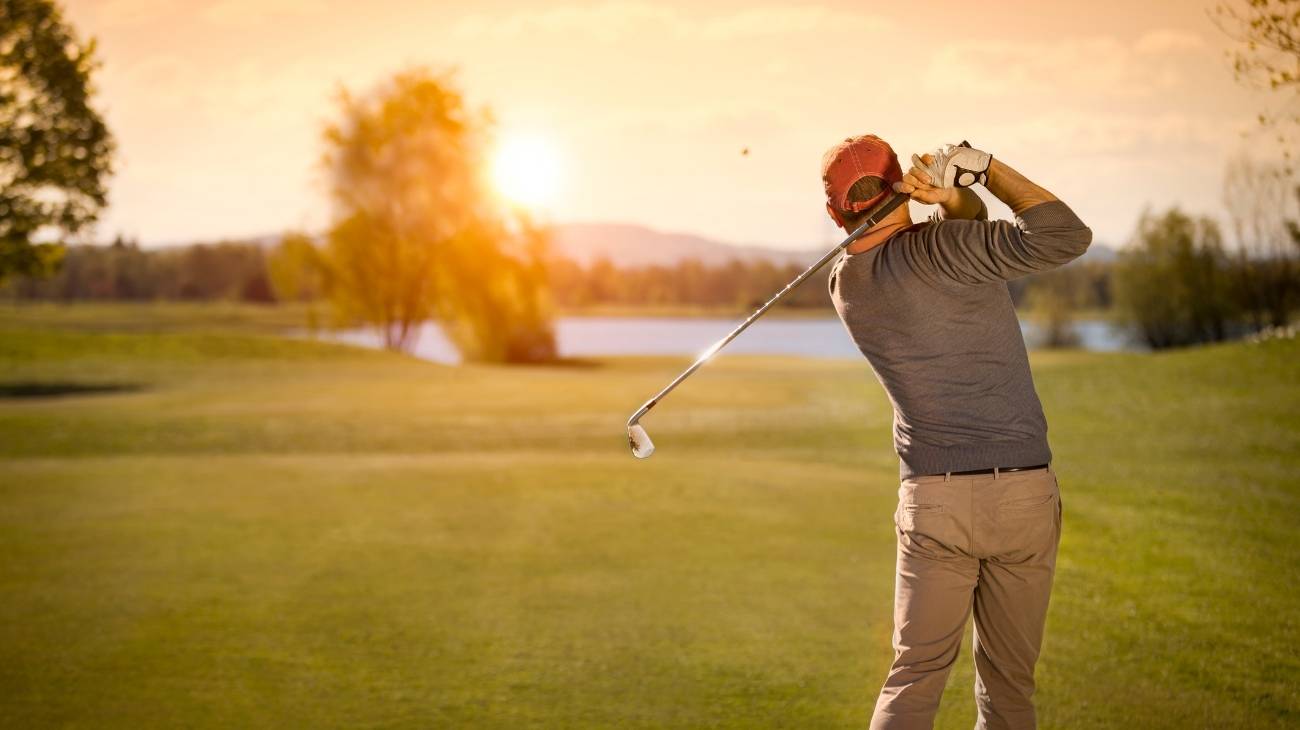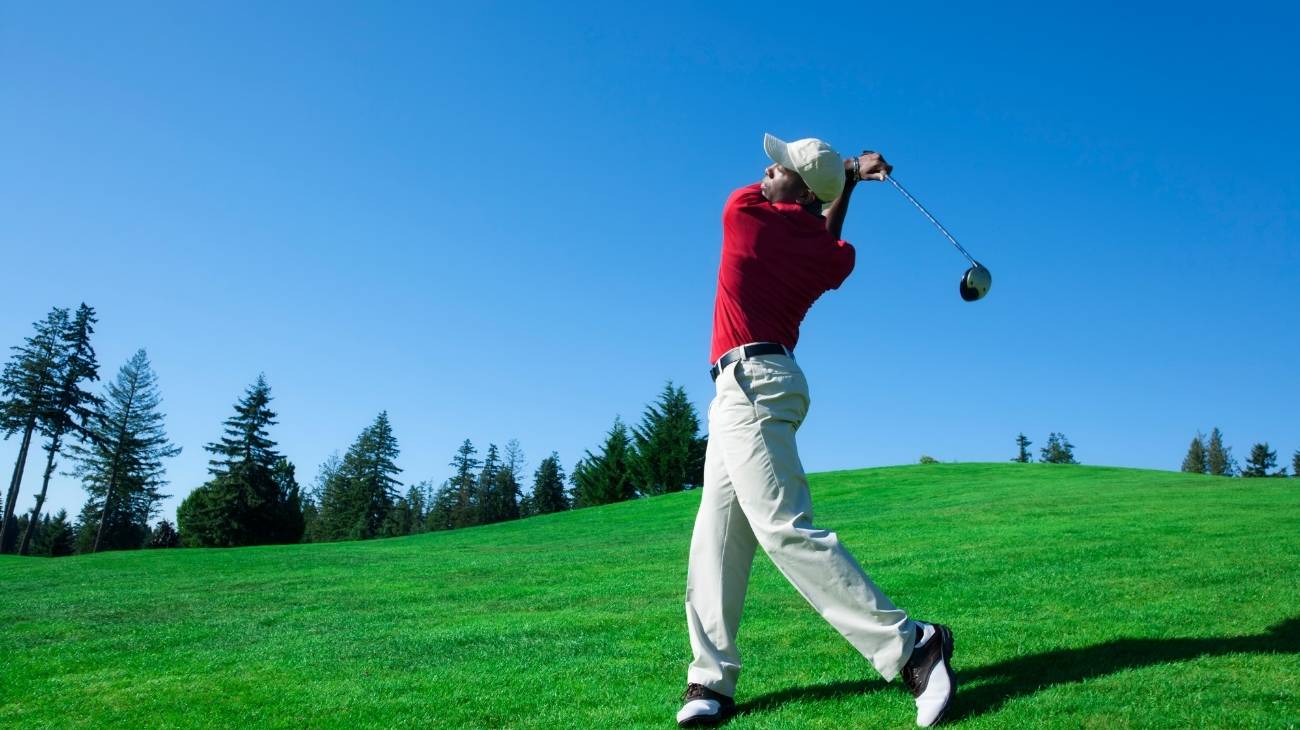For those who have never played golf, it may seem like a simple sport, without risk or technique. Golf challenges our technique and endurance, as we must hit the ball from the bottom upwards and this involves precise and intense muscular and joint work.
With the repetitions of the swing, comes a high number of injuries that we will explain in this article. In addition, you will learn what to do to prevent the most common golf injuries and how to apply the PRICE therapy as first aid for when you get injured after a few holes at your local club.
What are the most common types of golf injuries?
Although a golf ball weighs only 45 grams, it reaches a maximum speed of 330 km/h with a single powerful motion involving every joint in the body. These are the parts that suffer the most with the repetitions of the swing and here are the most common injuries you can suffer playing golf.
Epitrocleitis
The injury is better known as "golfer's elbow", it is the most frequent ailment generated after the tendons that allow the hand to close and the wrist to move due to the repetitive swing movements wear out. In this case, the pain is transferred to the inner part of the elbow and the entire forearm. The trigger is usually a very forceful twisting of the wrist in the direction of the palm of the hand, coupled with a bad warm-up makes it occur more frequently.
Fibre rupture
Occurs when there is a forced and excessive stretching of the muscle fibres during a powerful stroke. It is often a tear of just a few fibres and recovery takes only 7-10 days. You should be aware that the sport of golf is a medium intensity sport, so total tears are unlikely to occur.
It is advisable to watch out for minor muscle aches, bruising and difficulty moving your arm when swinging, as these symptoms are warnings from your body that can lead to a major injury. Metabolic diseases and a bad warm-up increase the risk of this injury.
Herniated discs
The discs in the spine serve as shock absorbers against the constant rotation of the trunk when hitting the golf ball. A herniated disc is the outward displacement of the disc due to tears in its intervertebral ring. All golf injuries revolve around the swing, as it is a mechanical movement and involves the back muscles. If the hernia is in the lower back, you will feel the pain immediately because of the difficulty and discomfort when turning the trunk.
This is an uncommon injury in amateur golfers as they will rarely push their body to the limit, which is the main cause of such a serious ailment, but in professionals it happens more frequently, so it is good to be aware that the possibility will always be present.
Anterior cruciate ligament injury
You'd be wrong if you thought this injury was only found in footballers or other impact sports. Golfers also suffer from it, such as Tiger Woods in 2008, who was sidelined for several months. This knee injury can be caused by poor swing technique that causes you to lose body stability and sprain your knee.
When it happens, the player suffers swelling, intense pain and the inability to move the knee freely and even to stand up. Unlike the previous injury, this one can occur in amateur golfers because if you don't have a good technique and you forget to fix your knees tightly, the weight and power of the swing can make you lose your balance and generate this sprain.
Rotator cuff tendonitis
When there are micro-tears in the rotator cuff fibres, the tendons become inflamed to the point of causing pain and problems moving the whole arm. The shoulder joints suffer because of the power that has to be applied to the ball to hit a long drive. The injury does not affect the rotator cuff as a whole, but it is a nuisance that affects its functioning.
If you play golf regularly, you are more prone to this injury, especially if you don't practice your shot-making technique, which is the main cause of strain on the ligaments and tendons of the shoulder rotator cuff.
Stress fracture
The metacarpals of both the hands and the metatarsals of the feet are prone to fracture from stress in training and from a bad shot in golf. Squeezing the hand hard while it is injured increases the risk of a fracture. In the case of the feet, it is caused by a bad turn of the ankle during the stroke, remember that this usually rotates at the end of the movement that drives the ball, generating a specific tension in the fifth metatarsal.
Achilles tendonitis
Playing and practising golf on very uneven ground causes the Achilles tendon to ache. There may not be a complete rupture of the tissue, but it will become inflamed, which is an injury to be taken into account in order to avoid greater problems, as if the foot continues to be forced, it could worsen.
This tendon is in the lower part of the calf and connects it to the heel. At the beginning of the inflammation, a slight pain is felt that subsides with a good rest and some therapies that we will discuss throughout the post.
Tendonitis of the adductors
Overwork from constant swings is often so intense in the hip that it leads to tendonitis in the adductors, the muscles that connect the leg to the core of the body and keep it stable. When this condition occurs, you feel an imbalance in your body and have difficulty maintaining the correct position for a good swing. The pain starts in the genital area and covers the entire hip and lower back.
Cervical pain
The Stance and Swing are two of the most important moments in golf and the ones that cause the most wear and tear on the neck. When there is a bad technique, we cause tension to accumulate in the back of the neck, generating a strong pain in this area. The flexion and rotation of the shoulder helps to hit the ball well, but when this tension is not distributed in a balanced way, it ends up injuring the first seven vertebrae of the spine.
Carpal tunnel syndrome
This ailment occurs when the median nerve in the hand, in the wrist area, is compressed excessively and repeatedly. This starts with an instability of the hand until it hurts when closing and moving the fingers. It is a common injury in golfers who frequently play full rounds, who have already put enough wear and tear on their hands to trigger this condition. Surgery is the most commonly used option to release the tension in the tendon, although there are conservative treatments that can help the injury to disappear.
Best products for golf injury recovery
Bestseller
-
2 Elbow Compression Sleeve (Black/Gray)
$19.95 -
2 Elbow Compression Sleeve (Green/Navy)
$19.95 -
2 Elbow Compression Sleeve (Pink/Bordeaux)
$19.95 -
2 Knee Compression Sleeve (Black/Gray)
$19.95 -
2 Knee Compression Sleeve (Green/Navy)
$19.95 -
2 Knee Compression Sleeve (Pink/Bordeaux)
$19.95 -
2 Tennis Elbow Brace (Black/Gray)
$14.95 -
2 Tennis Elbow Brace (Green/Navy)
$14.95 -
2 Tennis Elbow Brace (Pink/Bordeaux)
$14.95 -
Acupressure Mat and Pillow (Black/Gray)
$49.95 -
Acupressure Mat and Pillow (Green/Navy)
$49.95 -
Acupressure Mat and Pillow (Pink/Bordeaux)
$49.95 -
Acupressure Pillow (Black/Gray)
$29.46 -
Acupressure Pillow (Green/Navy)
$29.46 -
Acupressure Pillow (Pink/Bordeaux)
$29.46 -
Back Support Belt (Black)
$34.95 -
Back Support Belt (Green)
$34.95 -
Back Support Belt (Pink)
$34.95 -
Foot Massage Roller for Plantar Fasciitis (Black)
$19.95 -
Foot Massage Roller for Plantar Fasciitis (Green)
$19.95 -
Foot Massage Roller for Plantar Fasciitis (Pink)
$19.95 -
High Density Foam Roller for Muscle (Black/Gray)
$29.95 -
High Density Foam Roller for Muscle (Green/Navy)
$29.95 -
High Density Foam Roller for Muscle (Pink/Bordeaux)
$29.95 -
Ice Massage Roller Ball (Black)
$39.95 -
Ice Massage Roller Ball (Green)
$39.95 -
Ice Massage Roller Ball (Pink)
$39.95 -
Microwave Heating Pad for Back Pain Relief (Extra Large) (Hearts)
$29.95 -
Microwave Heating Pad for Back Pain Relief (Extra Large) (Oxford)
$29.95 -
Microwave Heating Pad for Back Pain Relief (Extra Large) (Sport)
$29.95 -
Microwaveable Heating Pad for Pain Relief (Hearts)
$19.95 -
Microwaveable Heating Pad for Pain Relief (Oxford)
$19.95 -
Microwaveable Heating Pad for Pain Relief (Sport)
$19.95 -
Pack 2 In 1 Foam Roller High + Soft Density (Black/Gray)
$29.95 -
Pack 2 In 1 Foam Roller High + Soft Density (Green/Navy)
$29.95 -
Pack 2 In 1 Foam Roller High + Soft Density (Pink/Bordeaux)
$29.95 -
Sacroiliac Support Belt (Black)
$24.95 -
Sacroiliac Support Belt (Green)
$24.95 -
Sacroiliac Support Belt (Pink)
$24.95 -
Shoulder Support Brace (Black)
$24.95 -
Shoulder Support Brace (Green)
$24.95 -
Shoulder Support Brace (Pink)
$24.95 -
Soft Density Foam Roller for Recovery (Black)
$29.95 -
Soft Density Foam Roller for Recovery (Green)
$29.95 -
Soft Density Foam Roller for Recovery (Pink)
$29.95 -
Trigger Point Massage Stick (Black)
$14.95 -
Trigger Point Massage Stick (Green)
$14.95 -
Trigger Point Massage Stick (Pink)
$14.95 -
Wrist Brace (Black/Gray)
$19.95 -
Wrist Brace (Green/Navy)
$19.95 -
Wrist Brace (Pink/Bordeaux)
$19.95
How to prevent injuries when playing golf?
Golf is a very technical, mechanical sport, in which muscle memory is important in order to hit the ball correctly in as few attempts as possible. For this reason, training and practising the swing are fundamental, so that the golfer can concentrate on the strategy to be carried out shot by shot.
Warm up
A golfer's joints must be at 100% for golf practice and tournaments. This is why stretching is essential, as well as joint mobility. Try doing circles with your shoulders, wrists, knees and ankles before choosing your golf club. Then make circular movements with your hips, always slowly and in both directions. Do the same movement with your neck, bringing your head forwards, backwards and sideways.
Then move your head in a circular motion. Remember to take your time with each step. When you have finished mobilising your joints, stretch the muscles of your arms, legs and lower back until your whole body is in a fit state for sport. Although it is a medium-impact sport, there is always a risk of slight and moderate injuries.
Cool down
At the end of an 18-hole circuit with your friends you will be very tense and even fatigued, so you can't just go home. By cooling down, you will gradually bring the joints and other muscles of the body back to a state of relaxation and rest, so that all that tension is released instead of being encapsulated.
To achieve this you just need to do a stretching session in which you give mobility to the joints, especially the lower back, shoulders and arms, which are the ones that accumulate the most tension after a day in which you can perform more than 72 swings.
Good equipment
It is important that players have the necessary equipment for a perfect, safe and comfortable game. Clothing should be tailored and although there is already a standard, the ultimate choice is up to the golfer. The shirt or polo shirt should be made of cotton, the best garment is one that allows the mobility of the shoulder and elbow to flow. Although it is unlikely to rain during a game, you should have a jacket that provides the waterproofing you need to continue playing as efficiently as possible.
On the other hand, although there is no heavy sweating in golf, unless the ambient temperature is very high, you can wear synthetic fabrics if you are comfortable in them. A good pair of golf trousers should serve two purposes: comfort and flexibility. They should not get in the way of the swing and should not chafe the crotch. Designs have changed a lot over the years, and although they look like smart dress trousers, they are actually sports trousers.
The footwear should not be heavy and in recent years studs have been added as it is a grass sport, thus giving greater stability to the foot during the blows. They must guarantee waterproofing, resistance and comfort when walking on uneven terrain. Finally, gloves and caps are allowed in golf, the materials are varied and must facilitate the exercise of golf at all times.
Nutrition and hydration
You may think that a golfer does not need to eat well, but this is a mistake. Your body will need a balanced diet based on the 3 main macronutrients, fats, proteins and carbohydrates, because all these elements make the body flexible, elastic and strong. Protein helps fight muscle fatigue and carbohydrates store energy in the body that will then be used by every muscle in the body to make a powerful swing.
Your diet should contain oatmeal, brown rice, potatoes, bread and pasta, if they can be wholemeal all the better. Remember that everything in excess is bad, so you should vary these foods between breakfast, lunch and dinner. As a golfer walks for four to five hours outdoors, hydration should be constant and in small quantities, without waiting until you are thirsty as this is a first sign of dehydration.
Glucose intake is recommended in golf, as it is useful for storing large amounts of energy that will later come out in the strokes and walks. Fresh fruit will serve you well for optimal glucose levels in the body.
Fitness
Whether you have a slim or stocky build, the important thing is that you know how to properly transfer the power from your muscles to the tip of the club as you hit the ball from the bottom up. So this is really a discipline where technique and accuracy come before physique.
But while it is not necessary to have an athletic body, it is highly recommended to train a little in the gym because the joints, tendons and ligaments must be in perfect condition. Walk and jog daily, do aerobic activities that allow you to have cardiac and pulmonary endurance, and strengthen your arms and wrists.
Recovery therapies
Whether to prevent or recover from injury, therapies are useful in expert hands. No physiotherapy technique should replace the warm-up, training and cool-down necessary to be in good technical and physical condition.
- Sports massage: There are two central purposes of a good massage: to make the body more resistant to injury and to facilitate recovery after mild to moderate injury. The first purpose is to reduce fatigue, relieve contractures and inflammation and preserve flexibility. When the tissues are more flexible and elastic, it is possible to endure more hours of training and practice, and to increase the intensity of training and practice.
- Use of cold and heat therapies: Depending on the use we want to achieve in the body, we can use cold or heat on the injuries or parts of the body we want to strengthen. What is cold for? It is used immediately after injury. The benefits are the reduction of blood circulation, the ice has an analgesic and anti-inflammatory effect, it also relieves pain and controls the expansion of the oedema that is observed on the surface of the skin. In turn, the heat increases the amount of blood circulating in the body, facilitates metabolic activity and also helps to improve muscle inflammation.
- Use of compression garments: These garments improve blood circulation, increase muscle performance, reduce tissue fatigue and serve as inflammatory protection against possible injuries. As in golf we want to give all these benefits to the joints, it is common to use ankle, knee, elbow and wrist braces. It all depends on whether there is some discomfort when practising or if there is a weak part that you want to strengthen.
- Use of acupressure therapies: This is a holistic therapy that seeks to better distribute the "Chi" energy in the body, channelling the accumulated energy in one part to relieve pain and relax the muscles. With the help of the fingers and palms of the hands, acupressure allows you to touch local and reaction points to lower the tension that accumulates in the knees, elbows, wrists and lower back. If you feel pain in this area, without having had an injury, this therapy is a good way to relieve those pains and get on with your life as normal.
- Use of thermotherapy and cryotherapy: As a way of preventing injury and addressing long-term ailments, these therapies are highly effective when applied by a specialist. Applying heat at high temperatures has completely therapeutic functions. Unlike ice which can last for 20 minutes, cryotherapy can only be used for a very short time as it is not something you should do on your own, but always in the hands of a health professional.
How to apply the RICE therapy to treat first aid injuries in golfers?
In the 1970s it began to be used in sports injuries, before this decade each step was used separately, without realising that together they had a better effect. PRICE is the updated RICE therapy, as it is better known in the sporting world.
- Protection: The golfer must be very attentive to ball strikes, as this is where most injuries result in this sport. Use a classic bandage to protect the injured area and buy time while an initial assessment is carried out.
- Rest: Continued movement will aggravate any injury. If the injury is to the foot, the athlete should be seated or lying down. Rest is relative, as you don't want to stop activity 100%, just no movement that could worsen the condition.
- Ice: Ice should be applied to the skin with the support of any surface that allows the transfer of cold. It should not be applied directly.
- Compression: Compression ankle, elbow and knee braces have a better effect in regulating swelling in players. If these supplies are not available, an elastic bandage will do a similar job.
- Elevation: Elevate the affected limb above the level of the heart, this will help to lower pain, reduce swelling and lower the extent of oedema.
When should we see a specialist for the treatment of injuries in golf players?
For moderate and severe injuries, you should see a sports doctor and then a physiotherapist. The former will assess the injury and propose treatments, the latter will carry them out and look for alternative ways to facilitate recovery from golf injuries.
Bone fractures of any kind are a reason for consultation, as well as grade II and III sprains, as these are ruptures of tendon fibres that must be treated by a doctor. Dislocations, dislocations, discomfort in the fingers and shoulder should also be treated by specialists.
In short, unless you can't relieve the pain with rest and cold within 72 hours, you should see your doctor to assess your condition so that specific treatments can be applied.
References
- Thériault, G., & Lachance, P. (1998). Golf injuries: an overview. Sports medicine, 26, 43-57. https://link.springer.com/article/10.2165/00007256-199826010-00004
- McCarroll, J. R. (1996). The frequency of golf injuries. Clinics in sports medicine, 15(1), 1-7. https://europepmc.org/article/med/8903705
- McHardy, A., Pollard, H., & Luo, K. (2006). Golf injuries: a review of the literature. Sports Medicine, 36, 171-187. https://link.springer.com/article/10.2165/00007256-200636020-00006
- Batt, M. E. (1992). A survey of golf injuries in amateur golfers. British journal of sports medicine, 26(1), 63-65. https://bjsm.bmj.com/content/26/1/63.short
- Edwards, N., Dickin, C., & Wang, H. (2020). Low back pain and golf: A review of biomechanical risk factors. Sports Medicine and Health Science, 2(1), 10-18. https://www.sciencedirect.com/science/article/pii/S2666337620300068
- Parziale, J. R., & Mallon, W. J. (2006). Golf injuries and rehabilitation. Physical Medicine and Rehabilitation Clinics, 17(3), 589-607. https://www.pmr.theclinics.com/article/S1047-9651(06)00028-3/fulltext
- Brandon, B., & Pearce, P. Z. (2009). Training to prevent golf injury. Current sports medicine reports, 8(3), 142-146. https://journals.lww.com/acsm-csmr/Fulltext/2009/05000/Training_to_Prevent_Golf_Injury.00011.aspx
- Fradkin, A. J., Cameron, P. A., & Gabbe, B. J. (2006). Opportunities for prevention of golfing injuries. International journal of injury control and safety promotion, 13(1), 46-48. https://www.tandfonline.com/doi/abs/10.1080/17457300500167693
- Metz, J. P. (1999). Managing golf injuries: technique and equipment changes that aid treatment. The Physician and Sportsmedicine, 27(7), 41-56. https://www.tandfonline.com/doi/abs/10.3810/psm.1999.07.917
- Lehman, G. J. (2006). Resistance training for performance and injury prevention in golf. The Journal of the Canadian Chiropractic Association, 50(1), 27. https://www.ncbi.nlm.nih.gov/pmc/articles/PMC1839980/













